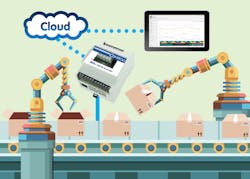Factory Management Made More Effective with Cloud Connection
Today’s modern factories depend on accessing and understanding data from their equipment, including devices at the edge of the network, to fully optimize operations. Leveraging cloud connectivity gives facility management mobility and global accessibility, reducing the overall management burden.
Cloud computing and Internet of Things (IoT) terminology are frequently used in our industry, but there is still a fair amount of confusion about the terminology and what can be achieved on the job site using cloud computing.
The BASpi-Edge series are hardened controllers that can deliver data to a cloud platform. Powered by Raspberry Pi, the controllers are networked via Ethernet or Wi-Fi and Azure IoT Central cloud connected, with enhanced features and data processing. A compact DIN-rail mounted enclosure with 24V ac/dc power input and a resilient 8 GB pSLC micro-SD card gives them performance and convenience advantages, making them suitable for a wide array of applications. They are installed on the edge of the IP network behind a firewall. Their built-in I/O allows connecting sensors and a programmable sequence of operation allow them to control equipment with built-in relays. The BASpi-Edge series simplify field device connectivity and securely connect to the cloud, effectively making any attached equipment a cloud connected asset.
The cloud is generally a server on the internet maintained by a service provider—such as Amazon Web Services (AWS) and Microsoft Azure—that provides a cloud-based platform, infrastructure, application or storage service, usually for a fee.
For large systems, there is generally a cloud specialist who sets up configurations and scripts to allow users to view data pushed to the cloud. For smaller systems, Microsoft Azure is an ideal fit for the BASpi-Edge. Users don’t need a dedicated cloud-management specialist. Instead, Azure offers IoT Central, which is a low cost, easy-to-use software-as-a-service (SaaS) solution (no cloud expert required) to view and graph the data sent from the BASpi-Edge.
To connect to the cloud using IoT Central and the BASpi-Edge, you must first create a "device" in IoT Central (one per BASpi-Edge) which will have three parameters—ID scope, Device ID and key—that must be added to the BASpi-Edge's cloud configuration webpage. Once configured with these three parameters and the points to push to the cloud are selected, the data from the BASpi-Edge will be in your IoT Central "device." Then, you need to create an IoT Central dashboard for your "device" to view the data.
The IoT Central dashboard can show you the sensor data sent by the BASpi-Edge to your IoT Central account. You can also view the current value of a point on the BASpi-Edge. In addition, you can graph data from the BASpi-Edge, showing one hour's worth of data (as shown in the accompanying image) or 30 days' worth of data.
Azure's IoT Central is a low cost, easy-to-use solution for viewing your data from the Internet. The BASpi-Edge can push its data to IoT Central but you can also control virtual points in the BASpi-Edge from IoT Central. These virtual points would then be applied to your BASpi-Edge control logic.
By leveraging the ready-to-use Azure IoT Central SaaS cloud solution, BASpi-Edge allows you to upload select, processed, triggered or all point data to the cloud securely where it can be trended, visualized, analyzed, alarmed and accessed from anywhere.
Built-in features include email alarming, scheduling, weather monitoring and graphical dashboards. These features make BASpi-Edge an extremely flexible small system supervisor, human to machine interface, or cloud-connected application specific controller. Communication over Ethernet or Wi-Fi and Sedona function block programmable control logic and data processing at the edge come standard.
Sedona is an open-source software environment designed to make it easy to build smart, networked, embedded devices which are well suited for implementing control applications. The Sedona language facilitates component-oriented programming where components are assembled onto a wire sheet, configured and then interconnected to create applications. Using a Sedona tool, such as Contemporary Controls’ free Sedona Application Editor, components deployed in kits are assembled and linked on wire sheets, creating applications that are executed by a Sedona device. Program changes are immediately executed.
BASpi-Edge controllers utilize the powerful 1.2 GHz 64-bit CPU in the Raspberry Pi 3 with 1 GB of RAM memory, Ethernet and Wi-Fi interfaces for versatile network connectivity, USB ports for extended functionality and an HDMI port for human-machine interface for touchscreen or display options. A field proven, resilient I/O and power circuit board installed on top hardens the Raspberry Pi and allows it to safely interface with standard industrial automation input/output control signals and industry standard power supplies. The 8 GB pSLC micro-SD card ensures reliable operation and sufficient storage space. The 24V ac/dc power input and a compact DIN-rail mounted enclosure make it convenient to install.
The BASpi-Edge is fully web page configurable with secure web page authentication. Its IP address on either Ethernet or Wi-Fi adapters can be configured for fixed IP, or it can receive an IP address automatically from a DHCP server on the network. Universal input channels are set for 0-10V input by default and are configurable for type II and type III 10 kΩ thermistor curves, a 20 kΩ thermistor curve, pulse inputs with or without pull up at up to 40 Hz or binary contact closure inputs (require a voltage-free source). An NTP server or manually settable clock allows for creating local schedules with holidays/exceptions. Email alarms/notifications are also web page configurable and allow for points or direct wire sheet values to be included in the sent emails.
A configurable weather station provides timely weather data parameters right to your wire sheet logic, graphical dashboard or pushed to the Azure IoT dashboard.
Graphical dashboards can be customized and accessed over Ethernet, Wi-Fi or directly out of the resident HDMI port. A built-in library of graphical widgets such as gauges, charts, sliders or buttons is used to display and/or control BASpi-Edge point values. Dashboards are accessible over the network but can also be displayed on an HDMI-connected screen. Graphical dashboards allow you to easily visualize your automation application.
The built-in cloud connector allows for quick and easy connection to the Azure IoT Central SaaS cloud. The cloud connection allows the user to upload select, processed or all point data to the cloud securely where it can be trended, visualized, analyzed, alarmed and accessed from anywhere giving your applications the mobility and global accessibility you have been looking for.


